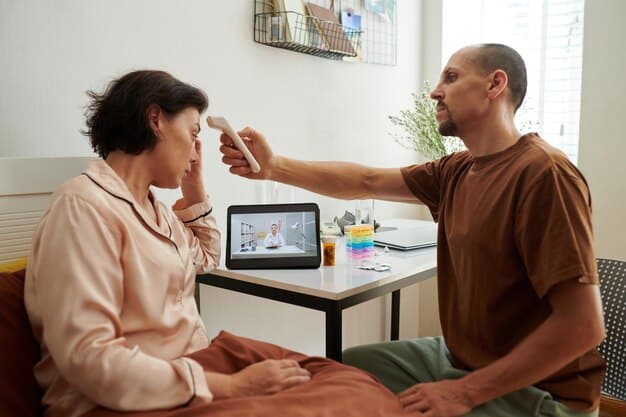Telehealth and the Opioid Crisis: Remote Addiction Treatment Solutions

Telehealth offers innovative solutions to combat the opioid crisis by providing remote addiction treatment, increasing access to care, and reducing the stigma associated with seeking help.
The opioid crisis continues to devastate communities across the United States, but telehealth and the opioid crisis: innovative solutions for remote addiction treatment are emerging as a powerful tool in combating this epidemic. By leveraging technology, telehealth is expanding access to care, reducing stigma, and providing flexible, patient-centered treatment options.
Understanding the Opioid Crisis in the US
The opioid crisis in the United States is a serious public health emergency resulting from the misuse and abuse of prescription and illicit opioids. Understanding the scope and impact of this crisis is the first step in addressing it effectively. The crisis affects millions of Americans, contributing significantly to morbidity and mortality rates and straining healthcare systems across the country.
The Scope of the Opioid Crisis
The opioid crisis involves a wide range of substances, including prescription painkillers like oxycodone and hydrocodone, as well as illicit drugs like heroin and fentanyl. The accessibility and addictive nature of these substances have led to widespread abuse, overdoses, and deaths.
Impact on Communities
The opioid crisis affects communities large and small, urban and rural. It is costly and devastating, with impacts ranging from increased crime rates to broken families and lost productivity. The economic burden on society is estimated to run into the billions of dollars annually.

These are the important issues to consider:
- Mortality Rates: Opioid overdoses are a leading cause of accidental death in the US, surpassing deaths from car accidents and firearms.
- Healthcare Costs: Treating opioid addiction and related health complications places a massive financial strain on healthcare providers and insurers.
- Social Consequences: Opioid addiction is associated with increased rates of crime, homelessness, and child neglect.
The opioid crisis demands a multifaceted approach, including prevention, treatment, and harm reduction strategies. Telehealth offers promising avenues for expanding access to these critical services, especially in underserved areas.
The Rise of Telehealth Solutions
Telehealth represents a significant shift in healthcare delivery by using technology to provide services remotely. This approach has proven invaluable in addressing various healthcare needs, and its application to addiction treatment is particularly promising.
What is Telehealth?
Telehealth involves delivering healthcare services using telecommunications technologies like video conferencing, mobile apps, and remote monitoring devices. It can encompass a wide range of services, from routine check-ups to specialized treatments.
Benefits of Telehealth
There are myriad benefits to using telehealth. Here are a few.
- Increased Accessibility: Telehealth removes geographic barriers, allowing individuals in rural or underserved areas to access specialized care.
- Reduced Costs: Telehealth can lower healthcare costs by reducing the need for travel, facility overhead, and in-person appointments.
- Improved Convenience: Telehealth offers patients greater flexibility and convenience, making it easier to fit appointments into their busy schedules.
- Enhanced Privacy: Many individuals prefer the privacy of telehealth consultations, which can help reduce the stigma associated with seeking mental health or addiction treatment.
Telehealth offers an efficient, cost-effective way to combat the opioid crisis, supplementing traditional treatments and offering new avenues for those in need.
Telehealth and Addiction Treatment: A Synergistic Approach
The integration of telehealth and addiction treatment creates a powerful synergy, enhancing the reach and effectiveness of care. Using technology to deliver addiction treatment has yielded promising results, addressing many of the barriers that traditionally hinder access to such services.
Remote Counseling and Therapy
Telehealth enables remote counseling and therapy sessions, providing patients with convenient access to mental health professionals from the comfort of their homes. This is particularly valuable for individuals who may have difficulty traveling to in-person appointments.
Medication-Assisted Treatment (MAT) via Telehealth
MAT, which combines medications like buprenorphine or naltrexone with counseling and behavioral therapies, is a cornerstone of addiction treatment. Telehealth facilitates the remote delivery of MAT, allowing patients to receive prescriptions and monitoring services without the need for frequent in-person visits.

Remote Monitoring and Support
Telehealth offers various other avenues of support.
- Wearable Devices: Wearable sensors can monitor physiological data, alerting providers to potential relapse triggers or health complications.
- Mobile Apps: Mobile apps provide tools for self-monitoring, education, and communication with healthcare providers.
- Virtual Support Groups: Online support groups connect patients with peers who share similar experiences, fostering a sense of community and mutual encouragement.
Telehealth is transforming addiction treatment, making it more accessible, convenient, and personalized. The benefits are clear, but effective implementation requires careful considerations and best practices.
Key Components of Successful Telehealth Programs for Opioid Addiction
To optimize the impact of telehealth programs addressing opioid addiction, several key components must be in place. These components ensure that the programs are not only accessible but also effective, safe, and patient-centered.
Ensuring Data Privacy and Security
Protecting patient data is paramount in telehealth. Programs must adhere to HIPAA regulations and implement robust security measures to prevent unauthorized access, breaches, and misuse of information.
Training and Support for Providers
Healthcare providers need adequate training and support to deliver effective telehealth services. This includes training on technology platforms, virtual communication skills, and best practices for remote patient assessment and management.
That’s not all that healthcare providers need:
- Culturally Sensitive Care: Telehealth programs should be designed to meet the diverse needs and preferences of different cultural groups.
- Integrating Telehealth with In-Person Care: Telehealth should complement, not replace, in-person care. Programs should be designed to integrate seamlessly with local healthcare systems, ensuring continuity of care.
- Addressing the Digital Divide: Efforts are needed to bridge the digital divide by providing affordable internet access, devices, and technical support to underserved populations.
By focusing on these components, telehealth programs can maximize their impact on the opioid crisis, ensuring that high-quality, patient-centered care is accessible to all.
Overcoming Challenges and Barriers in Telehealth Implementation
While telehealth offers tremendous potential, its successful implementation is not without its challenges. Addressing these barriers is essential to fully realize the benefits of telehealth and eliminate disparities in access to care.
Regulatory and Legal Issues
The legal and regulatory landscape surrounding telehealth is complex and constantly evolving. Varied state laws regarding licensure, reimbursement, and prescribing practices can create confusion and impede the interstate delivery of telehealth services.
Reimbursement Challenges
Lack of consistent reimbursement policies for telehealth services can also be a hurdle. While many private insurers and government payers now cover some telehealth services, reimbursement rates may be lower than those for in-person care, discouraging providers from offering telehealth options.
Technological Limitations
Technological hurdles may come up as well.
- Connectivity Issues: Poor internet connectivity, particularly in rural areas, can hinder the delivery of real-time video consultations and remote monitoring services.
- Lack of Technical Skills: Patients and providers may lack the technical skills needed to use telehealth platforms effectively. Training and support are crucial to address this barrier.
- Data Security Concerns: Concerns about data privacy and security can deter some individuals from using telehealth services.
Overcoming these challenges needs the coordinated effort of policymakers, healthcare providers, technology companies, and community stakeholders. Together, these issues can be overcome to enable an ongoing advance forward.
Future Trends and Innovations in Telehealth for Addiction Treatment
The field of telehealth is constantly evolving, fueled by technological advancements and increasing demand for accessible care. Several emerging trends and innovations hold promise for further enhancing the role of telehealth in addiction treatment.
Artificial Intelligence (AI) in Telehealth
AI is increasingly being used to personalize treatment plans, predict relapse risks, and provide virtual support to patients. AI-powered chatbots can offer immediate assistance and guidance, while machine learning algorithms can analyze patient data to identify patterns and predict outcomes.
Virtual Reality (VR) Therapy
VR therapy provides immersive and interactive experiences that can help patients manage cravings, practice coping skills, and address trauma. VR simulations can recreate real-world scenarios that trigger substance use, allowing patients to develop strategies for managing these situations in a safe, controlled environment.
As well, here are areas where Telehealth continues to develop:
- Integration of Wearable Technology: Wearable sensors and devices can track physiological and behavioral data in real-time, providing valuable insights into a patient’s condition and progress.
- Expansion of Telehealth to New Populations: Telehealth is increasingly being used to reach underserved populations, including adolescents, older adults, and individuals with co-occurring mental health disorders.
- Development of New Telehealth Platforms: Innovations in telehealth platforms are making it easier for patients and providers to connect, communicate, and collaborate.
Telehealth has a bright future. By embracing technology and innovation, telehealth can further expand access to care, improve outcomes, and help individuals overcome addiction and lead fulfilling lives.
| Key Points | Brief Description |
|---|---|
| 🚀 Increased Accessibility | Telehealth removes geographic barriers, making addiction treatment available to more people. |
| 🔒 Enhanced Privacy | Telehealth offers a private and confidential environment for seeking help. |
| 💰 Reduced Costs | Telehealth can lower expenses related to travel, facility fees, and hospitalizations. |
| 📱 Remote Monitoring | Telehealth tools and devices enable continuous monitoring of a patient’s condition. |
Frequently Asked Questions
▼
Telehealth involves delivering healthcare services remotely through technology, such as video conferencing, mobile apps, and remote monitoring devices. It enhances access to care and provides convenient, patient-centered solutions.
▼
Telehealth provides remote access to counseling, medication-assisted treatment (MAT), and support groups. It reduces stigma, increases convenience, and overcomes barriers to in-person care for addiction treatment.
▼
Benefits include increased accessibility, reduced costs, improved convenience, enhanced privacy, and better engagement in treatment. Telehealth provides a flexible and patient-centered approach to addiction care.
▼
Challenges include regulatory issues, reimbursement challenges, technological limitations, and concerns about data privacy and security. Addressing these barriers is crucial for successful telehealth implementation.
▼
Future trends include the use of artificial intelligence (AI), virtual reality (VR) therapy, integration of wearable technology, and expansion of telehealth to new populations. These innovations promise to improve care and outcomes.
Conclusion
In conclusion, telehealth offers transformative solutions for remote addiction treatment, addressing critical gaps in care accessibility and effectiveness. By leveraging technology, telehealth enhances privacy, reduces costs, and provides patient-centered support, revolutionizing the approach to the opioid crisis. While challenges remain in implementation, ongoing innovations promise a brighter future where telehealth plays an ever-increasing role in helping individuals overcome addiction and lead healthier lives.





